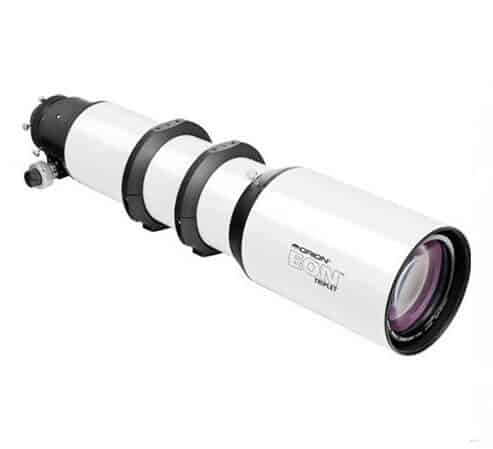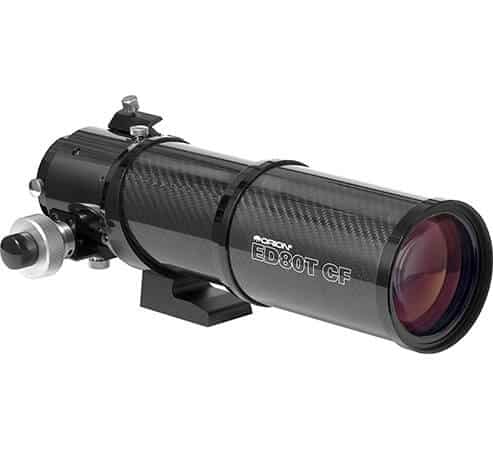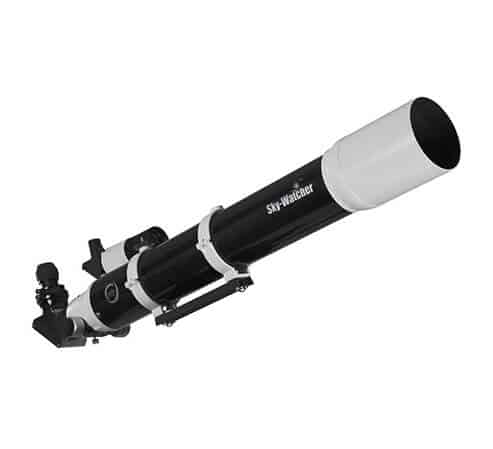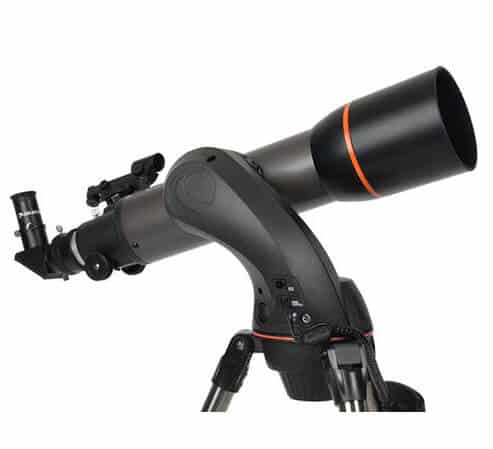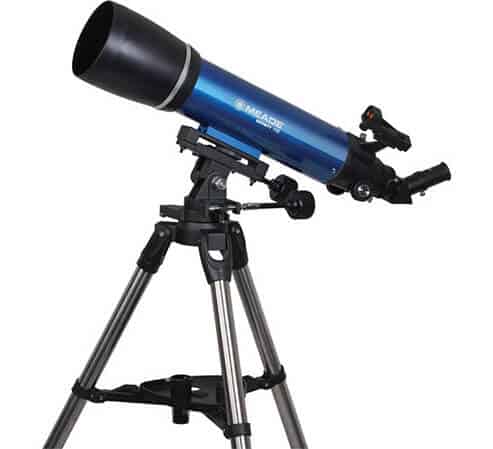Best Refracting telescopes
A Practical Buying guide
- Last Updated On:
Introduction
As an astronomer, you probably know that there are many different types of telescopes and that all of them have their place in an astronomer’s toolkit.
Today, we will review the best refracting telescopes on the market and give you enough information on choosing the best refractor based on your needs and budget.
There are many things that you need to look into when searching for a good refractor, but we will go through all of them one by one to make sure that you’re getting the best deal possible.
Quick Rundown
THESE ARE OUR TOP PICKS SUMMARISED FOR:
26th April 2024

- Premium, 130mm (5.1 inch) aperture.
- Huge 3 inch dual-speed (11:1)

- Fast f/6 focal ratio
- Lightweight yet strong carbon fiber tube

- 100 mm APO Refracto
- 900 mm focal length (f/9)

- High quality 102 mm short tube
- Good for terrestrial and celestial observing
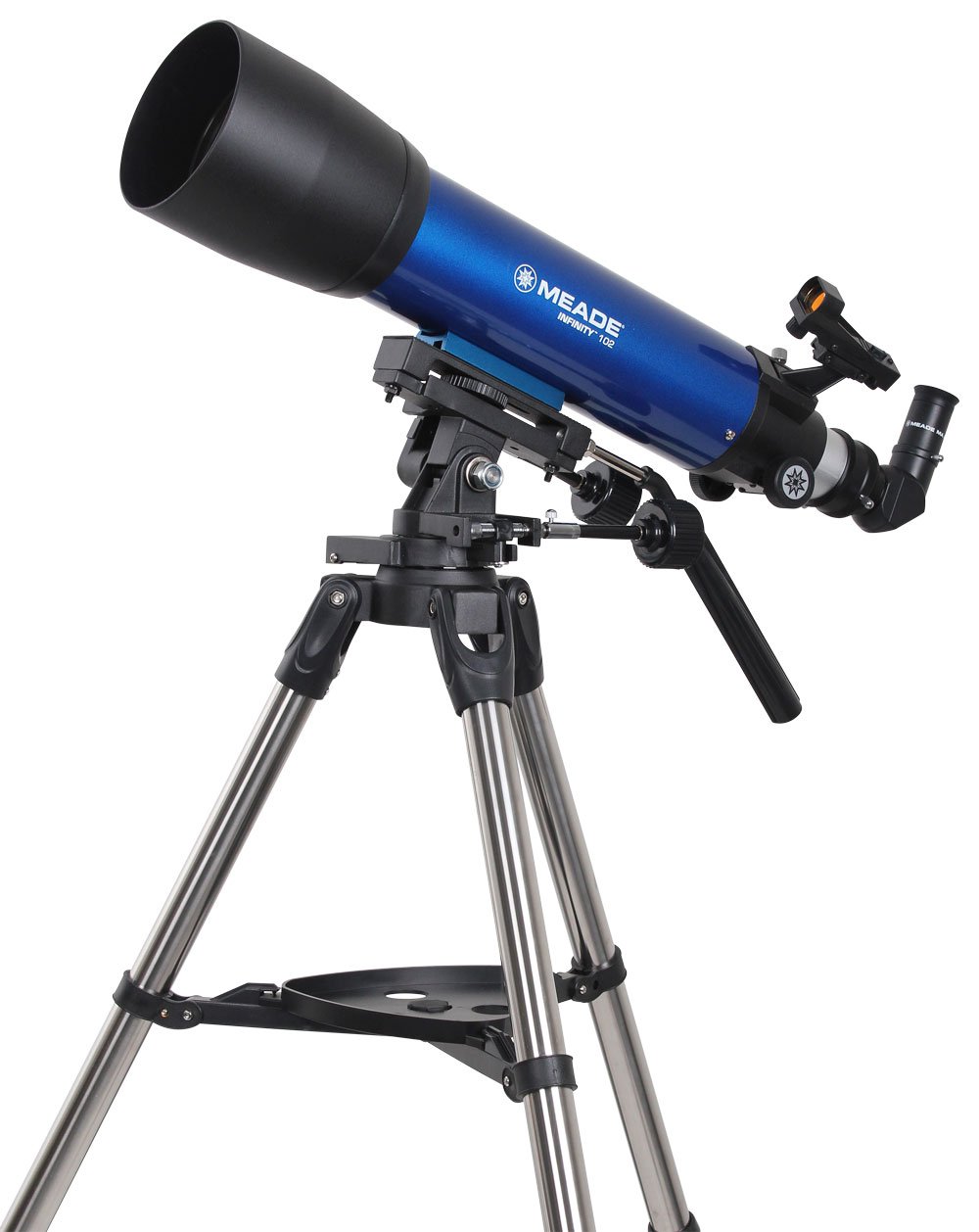
- Altazimuth mount with panhandle
- Includes Astronomical Software
What Makes a Great Refracting Telescope?
Telescopes come in different shapes, sizes and use different kinds of technologies. Refractor telescopes are no exception to this. So let us quickly take a look at what you should look out for when buying your first refractor.
APERTURE
Aperture is the most important feature of any telescope, including refractors. It is the diameter of the light collecting region, in our case the lenses. A telescope can gather more light if the diameter of its lens is higher, leading to brighter and sharper images. This, of course, allows for bigger magnification.
FOCAL LENGTH
The next important feature is focal length. This feature is important because it impacts the size of your telescope, the amount of chromatic aberration and the field of view. The focal length is described as the distance from a lens to the point at which parallel light rays converge. Planets generally benefit from longer focal lengths, but this is not always necessary. Focal length is tied to our next important feature.
PORTABILITY
he size and weight of individual parts will greatly impact portability, but so will focal length. Always keep in mind that you’re usually using your telescope with an additional mount, so the weight adds up. Shorter focal lengths make a telescope more portable, but suffer from field curvature and may require higher quality eyepieces to work properly.
Our preferred choices in terms of versatility are f/7 and f/8 apochromatic or at least achromatic refractors and we would recommend those to beginners. But, of course, if you have something very specific in mind and are buying your second or third telescope, we would recommend going with a very small or a very big focal length.
Table of Content
Top 5: Best Refracting Telescopes
Best Refractor Telescope for Astrophotography

APERTURE
130mm
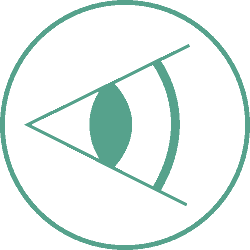
FOCAL LENGTH
910mm

MOTORIZED
No

Mount type
-
Overall:
The Orion EON 130 ED is a high-end triplet telescope, meaning that it makes use of high-quality apochromatic lenses that almost completely remove chromatic aberration. The massive 130mm aperture is paired with a moderate f/7 ratio, which makes this telescope very versatile and fantastic for astrophotography.
The telescope is fairly heavy, weighing 22,5 pounds (around 10 kg), which means that you need to be careful when choosing a suitable mount. We recommend the Sirius EQ-G stand, but the Orion Atlas stand should work fine, as well.
The coloration of the images is just as beautiful as the design of the EON 130. If you want to further improve the quality of your images, you might want to use a field flattener, but this is more of a recommendation than a real necessity.
Specifications:
- Aperture: 130mm
- Focal length: 910mm
- Focal ratio: f/7.0
- Coatings: Fully multi-coated
- Optics type: Air-spaced triplet
Conclusion:
If you want a real power horse for a somewhat steep, but still not insanely high price, then the Orion EON might just be what you’re looking for. It combines fantastic specs with a great design and is a nearly ideal tool for professional astrophotographers.
- A lot of aperture for a moderate price
- Fantastic, durable and elegant design
- A perfect telescope for astrophotography
- Slight field distortion, so you might want to use a field flattener for ideal results
- Somewhat heavy
- Ships without a mount

APERTURE
80mm

FOCAL LENGTH
480mm

MOTORIZED
No

Mount type
No Mount
Overall:
With an f/6 configuration, the Orion ED80T is bordering on the shorter side of refracting telescopes, but still lies in a solid all-around are, as well. With this affordable model, you have all the high-quality specs of a great, three-piece lens APO telescope, combined with the advantages of a fairly short focal length.
At around 10.5 pounds (around 5 kg), the telescope is fairly portable, though you will need to consider the weight of a stand that you want to use with this telescope, as well. Namely, the telescope ships without a stand, but that leaves you with the freedom of choosing one on your own.
As any real apochromatic telescope, the Orion CF Triplet features extra-low dispersion glass for a supreme viewing experience with virtually zero chromatic aberration, a fast focal ratio, and a solid 80mm aperture. The carbon fiber tube is one of the reasons for the low weight, but it is still very durable.
Specifications:
- Aperture: 80mm
- Focal length: 480mm
- Focal ratio: f/6.0
- Coatings: Fully multi-coated
- Optics type: Air-spaced triplet
Conclusion:
The Orion ED80T is a solid mid-range solution for beginners with a bigger budget or professionals who need a fast and portable scope. If you use it carefully, it will last you a long, long time and you will certainly enjoy using this little telescope.
You can also check it’s competitors in our buying guide for the best telescope under $1000.
- Great APO with solid aperture
- A great faster telescope to add to your collection
- Very lightweight and portable
- Dew shield parts are a bit flimsy, so you have to be careful
- Lens caps could use a bit more polishing, seem a bit rushed and rough
- Ships without a mount

APERTURE
100mm

FOCAL LENGTH
900mm

MOTORIZED
No

Mount type
Overall:
Doublets are achromatic telescopes that lie in-between the simple one-piece lens and the three-piece apochromatic lenses of triplets. The ProED Sky-Watcher is a prime example of how good a doublet should perform. With a 100 mm aperture, it gathers a lot of light, and the high focal length that results in an f/9 ratio makes this a very solid telescope for higher magnifications.
The ProED Doublet ships without a mount, but it does ship with 2 different eyepieces. At 28 pounds (around 12,5 kg), the telescope lies on the heavier side, and you have to consider the weight of the mount that you will get. You could, for example, check out the Celestron Advanced VX Series of mounts, or any compatible Sky-Watcher mount you prefer.
The images are fairly bright and exceptionally sharp, even at higher magnifications. With the included carrying case, the Sky-Watcher ProED is a great travel telescope despite its weight and focal length. If you want to go out of the city and explore some planets, the ProED will do great.
Specifications:
- Aperture: 100 mm
- Focal Length: 900 mm
- Focal Ratio: f/9
- Coatings: MHC Multi
- Coated Optics
- Optics type: ED Doublet
Conclusion:
While high-end triplets definitely outperform the Sky-Watcher ProED doublet, this telescope is still one of the best choices if you want to get a slow telescope for a fair amount of money. The two eyepieces and the carrying case make this bundle a sweet deal, even without a stand.
- High-aperture doublet
- Slow telescope for amazing planetary exploration
- Fantastic carrying case
- Somewhat on the heavier side
- Suffers from slight chromatic aberration
- Ships without a mount

APERTURE
102mm

FOCAL LENGTH
660mm

MOTORIZED
Yes

Mount type
Alt-Azimuth
Overall:
The NexStar series by Celestron is a fantastic series for users on a budget who are searching for a good quality product at a fair price. The NexStar series is fully computerized and motorized, making it useful for beginners, and as the mount is included, you won’t have to deal with searching for a mount that would fit your telescope. For a fairly low amount of money, you get a lot of products!
The Celestron 102 SLT comes with a few drawbacks when compared to more expensive models. First of all,
the telescope doesn’t use any technology to reduce chromatic aberration. Second, the fairly stable Alt-Az mount does not go beyond 70 degrees up, so looking at the zenith is near impossible without some kind of workaround.
Finding a good computerized refractor for a low price is very tricky, but we think that despite some drawbacks, the NexStar 102 SLT is an amazing find, especially for beginners. The Celestron App,
the computerized mount and the very high aperture despite the low price make this telescope a real hidden gem.
Specifications:
- Aperture: 102mm
- Focal Length: 660mm
- Focal Ratio: f/6.47
- Coatings: Multi-Coated
- Optics type: Achromatic
Conclusion:
The Celestron NexStar 102 SLT is the ideal choice for beginners or people who want to try out a computerized telescope without spending too much money. If you don’t mind the aberration, you will be very happy with this purchase. You can also check the best celestron telescopes or the best telescopes under $500.
- High-aperture and good finderscope for little money
- Stable, computerized mount
- Can be upgraded
- Suffers from chromatic aberration
- Mount has limited mobility
- Hard to get a perfect focus

APERTURE
102mm

FOCAL LENGTH
600mm

MOTORIZED
No

Mount type
Alt-Azimuth
Overall:
Meade Instruments produces amazing low-budget telescopes aimed at beginners and people who don’t want to spend a lot of money on a hobby. The Infinity series offers very good optics and a mount for a fairly low price.
The Meade Instruments Infinity 102mm AZ Refractor is a solid entry-level telescope that comes shipped with a mount, an extremely high aperture considering the price, and three different eyepieces.
The 5.9 focal ratio is solid for beginners and with the help of the red dot finder, you will be able to master this telescope in no time.
But, as with most low-end refractors, this one suffers from a lot of chromatic aberration. Getting ideal images with this telescope will not be easy, but if you want to try out astrophotography alongside sky exploration, this telescope might do the trick. All in all, you can hardly get any more quality at this price point, so we think that the drawbacks are to be expected.
Specifications:
- Aperture: 102mm
- Focal Length: 600mm.
- Focal Ratio: f/5.9
- Coatings: Fully Coated
- Optics type: Achromatic
Conclusion:
The Meade 102 refractor is very solid for beginners on a tight budget, but keep in mind that for more advanced research, you will need to upgrade in the future. The portability of the telescope makes it easy to get out of the city to get somewhat better results, but the telescope simply can not compete with the more expensive models.
You can also compare it with some competitors on this guide.
- Big diameter and solid focal ratio
- Stable mount that is easy to move
- Very lightweight
- Focus knob could be better
- Not the clearest images possible
What Are Refracting Telescopes?
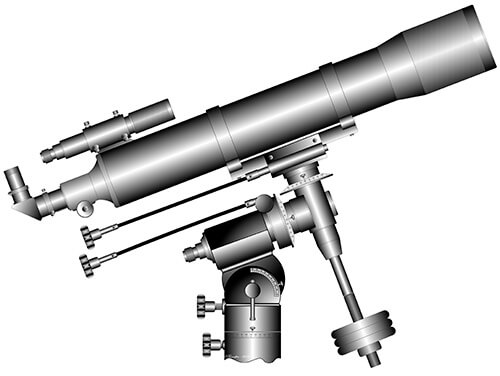
The first question you may be asking yourself is what is a refractor? Among different telescope types, refracting telescopes make up a big group of similar models that all work on the principle of refracting light, as opposed to reflecting it in the case of reflector telescopes.
A refracting telescope uses a lens as its objective to form an image. These were the earliest type of optical telescopes, developed in Europe around the 1600s. Galileo Galilei was fascinated by the invention and made a version of it on his own, which lead to increased popularity of the device.
There have been 4 main stages in the development of the refracting telescopes, but despite the improvements, all 4 types can be still found today, mostly because of the lower production cost and smaller size of the older models. The 4 stages include the Galilean telescope with a concave lens; the Keplerian telescope, which uses a convex lens; Achromatic refractors which use more complex lenses made of two pieces to reduce chromatic and spherical aberration; and Apochromatic refractors, which use three-piece lenses for even better reduction of aberration.
Reflector vs Refractor Telescopes:
A question that people often ask before getting a telescope is whether reflecting telescopes are better or if refracting telescopes offer the superior experience. The answer is sadly not easy to answer and it depends on a lot of factors.
Refractors, by default, are more expensive than reflecting telescopes, but you can find very different models of both categories for very different prices. As a rule of thumb, refracting telescopes suffer from chromatic and spherical aberration, especially if they are not apochromatic telescopes. Refractors with lower f-ratios suffer from this disadvantage even more than the ones with higher f-ratios.
Still, there are advantages to refractors. They are beginner-friendly, require less maintenance as they usually have a sealed-tube design, and in inferior conditions, they generally perform better than reflector telescopes. While the initial cost is somewhat higher, refractors can be a lot of fun and easy to use, although the longer focal ratios can make some of these telescopes cumbersome.
Another rule of thumb is that reflecting telescopes are better for deep-sky observation (nebulae, galaxies, and clusters), while refractors are more suited for viewing closer, bigger and brighter objects like the planets of our solar system and their moons.
But, of course, as with many other products, there are also hybrid variants that are presented as a solution to all disadvantages and that have all the advantages of both types. Catadioptric telescopes are an in-between solution that might appeal to both lovers of reflectors and fans of refractors.
What To Expect From Refracting Telescopes?
After reading through all the important features and the unique characteristics of refracting telescopes, you should by now have an idea what to expect.
To summarize, refractors generally offer a more simple design which is tied to ease of use, making them a bit more beginner friendly, though they do come at a somewhat steeper price point compared to the same-quality reflectors. Here is a short pros and cons overview of the features of refractors:
Advantages:
Simple design that requires little maintenance.
No need for collimation or alignment of optics.
Better contrast than reflectors.
Unobstructed view without complex calculations of contrast performance and effective apertures.
Great for viewing neighboring planets, the Moon or terrestrial viewing.
Disadvantages:
Tend to be more expensive.
Require large apertures and focal lengths for best results.
Chromatic aberration unless achromatic models are used.
Heavier because of bigger lenses and longer apertures.
CONCLUSION
Money can get you a lot of good features, but for each price range, there are many different models and not all of them are equally good. We have given our best to review many different models and compare them to each other.
If you want even more information on different telescope types and what features you should look out for, make sure to take a look at telescope introduction guide and there, you will also be able to find additional in-depth articles about many different telescope types (best telescope for beginners and telescopes by aperture size.
We hope that you have enjoyed our article and that you share our opinion on the models. We are happy to hear from you, so send us feedback and tell us what you think is the best refractor telescope on the market!
SUBSCRIBE TO OUR WEEKLY NEWSLETTER
